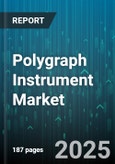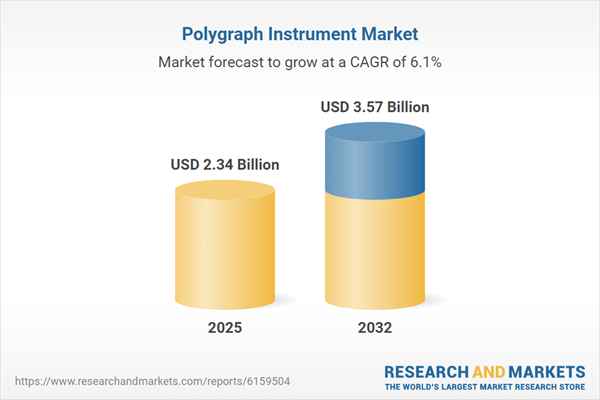Speak directly to the analyst to clarify any post sales queries you may have.
Strategic Prelude Outlining the Evolutionary Trajectory and Critical Context of the Polygraph Instrument Market for Informed Decision-Making
The polygraph instrument market has evolved from a niche investigative tool into a sophisticated ecosystem of technologies crucial for security, research, and human resource functions. Over the past decade, advancements in sensor accuracy, data processing algorithms, and user interface design have redefined the capabilities and applications of polygraph instruments. This introduction establishes the foundational context by examining how scientific rigor, regulatory scrutiny, and end-user requirements converge to shape the market’s trajectory.Against a backdrop of growing global demand for credible truth verification and risk assessment solutions, stakeholders are navigating a landscape where technological innovation intersects with ethical considerations and legal frameworks. Understanding the interplay between analog legacy systems and emerging digital platforms is critical for stakeholders seeking to align investments with long-term strategic goals. By framing the evolution of polygraph technology within broader industry trends-such as the rise of wearable devices, the integration of artificial intelligence, and heightened data privacy standards-this section sets the stage for a deeper exploration of transformative shifts and actionable insights. It also highlights the importance of adopting a holistic perspective that recognizes both the scientific underpinnings and the practical implications of polygraph instrumentation in real-world settings.
Emerging Paradigms Redefining the Polygraph Instrument Landscape Through Technological Innovation, Regulatory Evolution, and Shifting End-User Expectations
In recent years, the polygraph instrument landscape has undergone a series of paradigm shifts driven by the convergence of digital transformation, regulatory evolution, and shifting stakeholder expectations. First, the migration from analog to fully digital platforms has accelerated, enhancing accuracy and reducing signal noise through advanced algorithms. This technological leap has not only improved the reliability of results but also expanded the scope of applications to include high-stakes criminal investigations and corporate risk management.Concurrently, regulatory bodies across multiple jurisdictions have introduced more stringent standards for examiner certification, data handling, and reporting protocols. These guidelines are reshaping vendor strategies, compelling them to invest in compliance frameworks and transparent audit trails. Furthermore, end users now demand more intuitive interfaces and streamlined workflows, prompting manufacturers to develop portable and wearable devices that facilitate on-site testing in law enforcement, military operations, and academic research. As a result, the market is witnessing the emergence of hybrid solutions that blend hardware robustness with cloud-based analytics, enabling real-time insights and remote supervision.
Assessing the Compound Effects of United States Tariff Adjustments on Polygraph Instrument Supply Chains and Total Cost Dynamics in 2025
The introduction of new tariff measures by the United States in 2025 has had a pronounced cumulative impact on the polygraph instrument supply chain and cost structures. Suppliers reliant on imported components have faced elevated duties, prompting many to reassess sourcing strategies and pursue alternative regional manufacturing partnerships. This shift has driven a gradual realignment of production footprints, with several key players establishing assembly lines in neighboring markets to mitigate tariff-related cost burdens.Moreover, the increased import levies have influenced procurement decisions for end users in sectors such as government agencies and corporate security departments. Budgetary constraints have led procurement officers to evaluate not only unit pricing but also total cost of ownership, factoring in maintenance, software updates, and extended warranties. In response, manufacturers are offering bundled service agreements and modular upgrade paths to offset the financial strain of tariff-induced price hikes. Consequently, the tariff environment is fostering greater collaboration between suppliers and clients, as both parties seek to optimize value through shared investments in customization and lifecycle support.
In-Depth Exploration of Polygraph Instrument Market Segmentation Across Product, Component, Technology, Test, Category, Application, and End-User Dimensions
The landscape of polygraph instrumentation can be dissected along several dimensions that reveal distinct patterns of adoption and investment. Based on product type, instruments are categorized into analog and digital platforms, each offering unique trade-offs between traditional reliability and cutting-edge data analytics. Analog systems continue to serve foundational testing needs, while digital solutions integrate advanced signal processing and user-friendly interfaces.Component segmentation underscores the value derived from hardware precision, software enhancements, and service offerings. High-precision sensors and durable electrodes represent the hardware core, whereas analytical software and data visualization modules elevate the interpretive rigor of test results. Complementing these are professional services that include examiner training, certification support, and technical assistance. In terms of technology type, desktop devices remain prevalent in controlled environments, while wearable variants cater to on-site and mobile testing scenarios, expanding operational flexibility.
Examining test types reveals a broad repertoire-from the comparison question test and control question test to the guilty knowledge test, relevant irrelevant test, and zone comparison test-each designed to address varying investigative objectives. Category segmentation differentiates wired and wireless instrument configurations, the latter enabling greater tester mobility without compromising data integrity. Application segmentation spans academic and research institutes, criminal investigation units, pre-employment screening services, and security and surveillance operations, reflecting the technology’s multidisciplinary relevance. Finally, end users range from corporate HR departments and government agencies to law enforcement divisions, military and defense establishments, and specialized private investigation firms, illustrating a diverse stakeholder ecosystem.
Comparative Regional Analysis Revealing Distinct Adoption Patterns and Regulatory Influences Across the Americas, EMEA, and Asia-Pacific
Regional dynamics play a pivotal role in shaping the adoption and innovation trajectories of polygraph instrumentation. In the Americas, mature public safety infrastructures and well-established certification bodies drive steady demand for both analog and digital solutions. North American law enforcement agencies and corporate compliance departments often pioneer early adoption of advanced features, thereby influencing global best practices.Across Europe, the Middle East, and Africa, regulatory diversity and varying levels of infrastructural development lead to a more fragmented landscape. Western European nations emphasize stringent examiner accreditation and data protection standards, whereas emerging economies in the Middle East and Africa prioritize cost-effective systems and scalable training programs. In contrast, the Asia-Pacific region exhibits rapid uptake of wearable and cloud-enabled instruments, fueled by a surge in criminal investigation funding and an expanding academic research community. This regional mosaic underscores the importance of customized go-to-market approaches that align with local regulatory frameworks and budget realities.
Profiling Key Industry Players Driving Innovation and Competitive Differentiation Through Strategic Partnerships, Advanced R&D, and Comprehensive Service Solutions
Leading companies in the polygraph instrument arena differentiate themselves through targeted R&D investments, strategic partnerships, and comprehensive service ecosystems. Several key vendors have unveiled next-generation digital analyzers that incorporate artificial intelligence to detect subtle physiological cues, thereby improving the speed and accuracy of assessments. Others have focused on expanding service portfolios, offering turnkey solutions that include examiner training, certification tracking, and ongoing technical support.Collaborations between instrument manufacturers and cloud analytics providers are also reshaping the competitive landscape. By integrating secure, cloud-based platforms, vendors can deliver real-time data aggregation, remote monitoring of examination sessions, and automated compliance reporting. Additionally, mergers and acquisitions have consolidated expertise across hardware, software, and services, enabling some organizations to present end-to-end solutions that address the full lifecycle of polygraph testing. These strategic moves are intensifying competition and elevating customer expectations for innovation and service quality.
Actionable Strategies for Industry Leaders to Enhance Platform Modularity, Strengthen Compliance Partnerships, and Elevate Customer Success Initiatives
Industry leaders should prioritize investments in modular, scalable platforms that balance hardware durability with software agility. By embracing open architecture designs, manufacturers can facilitate seamless integration with third-party analytics engines and enterprise security systems. Furthermore, cultivating partnerships with regulatory bodies and certification agencies will ensure that product roadmaps remain aligned with evolving compliance requirements.Organizations must also expand examiner training programs to include advanced data analytics and ethical guidelines, thereby safeguarding the integrity of test outcomes. In addition, exploring opportunities to develop wireless and wearable polygraph solutions can capture emerging use cases in field operations. To bolster resilience against supply chain disruptions, leaders should diversify component sourcing across multiple regions and forge long-term agreements with alternate suppliers. Lastly, dedicating resources to customer success initiatives-such as on-demand technical support and routine software updates-will reinforce loyalty and generate recurring revenue streams.
Comprehensive Triangulated Research Methodology Integrating Primary Interviews, Secondary Data Analysis, and Expert Validation to Ensure Analytical Rigor
This research draws upon a triangulated methodology combining primary interviews, secondary data analysis, and expert validation. Primary research involved structured conversations with industry stakeholders, including instrument manufacturers, certified examiners, and end-user organizations, to capture firsthand perspectives on technological adoption and regulatory impacts. Secondary sources comprised regulatory guidelines, academic publications, and company disclosures, providing a comprehensive evidence base for trend analysis.Quantitative data were synthesized using statistical techniques to identify demand patterns, segmentation performance, and regional variances. Qualitative insights were incorporated through thematic analysis of interview transcripts, ensuring that contextual nuances and stakeholder sentiments informed interpretation. All findings underwent rigorous validation through iterative consultations with subject-matter experts, enabling refinement of insights and confirmation of the analytical framework. This robust methodology underpins the credibility and reliability of the conclusions presented throughout the report.
Synthesis of Key Market Trends Emphasizing the Imperatives for Modular Solutions, Service Ecosystems, and Collaborative Innovation
The polygraph instrument market stands at the confluence of technological innovation, regulatory evolution, and diverse application demands. As digital and wearable platforms gain traction, stakeholders must navigate an increasingly complex environment where examiner accreditation, data privacy, and total cost considerations are paramount. Regional distinctions further underscore the need for tailored market strategies that resonate with local compliance frameworks and budget constraints.Looking ahead, the ability to deliver modular, scalable solutions-coupled with robust service ecosystems-will differentiate market leaders from followers. Collaboration across the value chain, including partnerships with regulatory bodies and cloud analytics providers, will accelerate innovation while safeguarding the integrity of test outcomes. By aligning product development, training, and customer support initiatives with emerging trends and stakeholder expectations, organizations can capitalize on new growth avenues and reinforce their competitive positioning in this dynamic market.
Market Segmentation & Coverage
This research report forecasts the revenues and analyzes trends in each of the following sub-segmentations:- Product Type
- Analog
- Digital
- Component
- Hardware
- Services
- Software
- Technology Type
- Desktop
- Wearable
- Test Type
- Comparison Question Test
- Control Question Test
- Guilty Knowledge Test
- Relevant Irrelevant Test
- Zone Comparison Test
- Category
- Wired
- Wireless
- Application
- Academic & Research
- Criminal Investigation
- Pre-Employment Screening
- Security & Surveillance
- End User
- Corporate HR
- Government Agencies
- Law Enforcement
- Military & Defense
- Private Investigation Agencies
- Americas
- North America
- United States
- Canada
- Mexico
- Latin America
- Brazil
- Argentina
- Chile
- Colombia
- Peru
- North America
- Europe, Middle East & Africa
- Europe
- United Kingdom
- Germany
- France
- Russia
- Italy
- Spain
- Netherlands
- Sweden
- Poland
- Switzerland
- Middle East
- United Arab Emirates
- Saudi Arabia
- Qatar
- Turkey
- Israel
- Africa
- South Africa
- Nigeria
- Egypt
- Kenya
- Europe
- Asia-Pacific
- China
- India
- Japan
- Australia
- South Korea
- Indonesia
- Thailand
- Malaysia
- Singapore
- Taiwan
- Lafayette Instrument Company
- Stoelting Co.
- Axciton Systems, Inc.
- Converus, Inc.
- B.E.A.R. FORENSICS
- NIHON KOHDEN CORPORATION.
- SKRIP ELECTRONICS
- M/S MICRO TECNIK
- Medicaid Systems
Table of Contents
3. Executive Summary
4. Market Overview
7. Cumulative Impact of Artificial Intelligence 2025
Companies Mentioned
The companies profiled in this Polygraph Instrument market report include:- Lafayette Instrument Company
- Stoelting Co.
- Axciton Systems, Inc.
- Converus, Inc.
- B.E.A.R. FORENSICS
- NIHON KOHDEN CORPORATION.
- SKRIP ELECTRONICS
- M/S MICRO TECNIK
- Medicaid Systems
Table Information
| Report Attribute | Details |
|---|---|
| No. of Pages | 187 |
| Published | October 2025 |
| Forecast Period | 2025 - 2032 |
| Estimated Market Value ( USD | $ 2.34 Billion |
| Forecasted Market Value ( USD | $ 3.57 Billion |
| Compound Annual Growth Rate | 6.1% |
| Regions Covered | Global |
| No. of Companies Mentioned | 10 |









